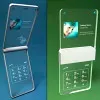Cell Jammer

A cell jammer, or cell phone blocker, is an invention that interferes with the radio waves used by cell phones.
This interference will block cell phone calls because it disrupts the transmission between a cell phone and a service network's cellular towers.
A "jammed" phone can't connect and will simply indicate no service to the user.
How It Works
Get a 9-volt battery and a quarter. Find an AM/FM radio and adjust the tuning dial until you get only static.
While holding the battery close to the antenna, tap your quarter across the two terminals. You will hear the tapping on the radio.
The battery/quarter is actually a wireless transmitter. It's not very powerful and it can't block your radio reception but if it was more powerful you could interfere with radio waves over a wider range. That's how a cell phone signal blocker works.
The physicist James Maxwell predicted the existence of radio waves in the 1860's, and in 1886, the physicist Heinrich Hertz demonstrated that rapid variations of electric current would project radio waves through space.
It was this discovery that eventually led to numerous wireless communication inventions (radio, television, remote controls, satellites, cell phones etc.)
These devices work within specific frequencies which are regulated by governments. A frequency is the number of waves that pass through a given point per second (cycles per second).
These cycles are called Hertz (Hz) named after Hertz. If a device has a frequency of 100 Hz, it means that 100 waves are passing through a given point in one second.
Radio wave frequencies range as low as 3 Hz to as high as 1 Gigahertz.
Aircraft communicate in frequencies between 30 to 300 Mhz.
Submarines communicate in frequencies between 3 to 30 Hz.
Radio stations broadcast in frequencies between 148 kHz to 1710 kHz and a tuner on a radio allows you to "tune in" to a specific frequency so you can listen to a specific radio broadcast.
Cell Phone Blocker
![]()
Cell phones work in frequencies between 800 Mhz and 1900 Mhz. A cell phone blocker transmits interference for these frequencies which targets cell phones.
Most countries regulate and/or prohibit the use and ownership of a cell jammer.
In some countries a cell blocker may be used within schools, jails, banks, libraries, churches, concert venues, restaurants, hospitals or movie theaters.
Law enforcement and the military can deploy radio frequency jamming. A powerful tactical response jammer can disable all communications in a very large area.
For example, the TRJ-89 tactical jammer can create a blanket of "RF silence" over a 5 mile (8 km) radius. This would effectively create a "dead zone" for communications.
Sources: eodpartner.com; netline.co.il




